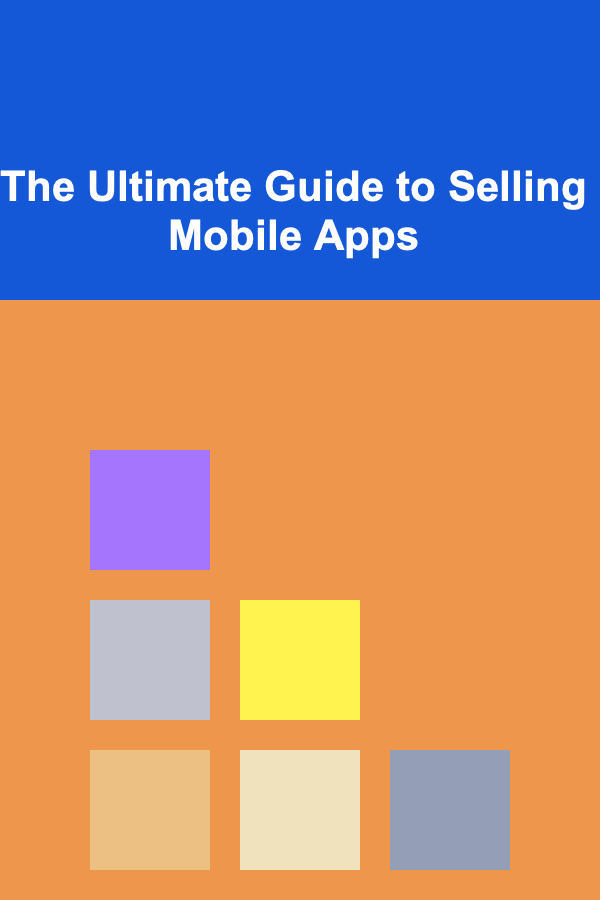
The Ultimate Guide to Selling Mobile Apps
ebook include PDF & Audio bundle (Micro Guide)
$12.99$11.99
Limited Time Offer! Order within the next:

Creating and launching a mobile app can be an exciting and rewarding endeavor. However, developing a successful app is only part of the journey. In today's competitive marketplace, selling your mobile app effectively is just as important. Whether you are a solo developer or part of a larger team, understanding how to sell your app is essential for turning your idea into a profitable venture.
In this guide, we'll walk through actionable strategies and practical steps to help you successfully sell your mobile app, increase downloads, and build a profitable business.
Understanding the Market and Audience
Know Your Niche
Before you can effectively sell your app, it's crucial to understand the market and identify your target audience. This foundational step will guide your marketing and sales strategies.
- Research Competitors: Look for apps that are similar to yours. What are they doing well, and where do they fall short? Understanding your competition can help you position your app more effectively.
- Define Your Target Audience: Who will benefit most from your app? Is it for casual users or professionals? Do you target a specific geographic region or a particular age group? Identifying your audience will help refine your messaging and marketing efforts.
- Identify the Problem Your App Solves: Apps that solve specific problems or address clear pain points tend to do better. Be clear about the problem your app solves and make sure that your target audience understands how it will improve their lives.
Perfect Your App Store Listing
Your app's listing in the App Store or Google Play Store is your first point of contact with potential users. A well-optimized app store listing can significantly increase your app's visibility and download rate.
App Store Optimization (ASO)
Just as websites need SEO (Search Engine Optimization), apps need ASO to get noticed. ASO helps your app rank higher in app store search results, making it more likely to be discovered.
- Keyword Research: Use tools like App Annie, Sensor Tower, or Mobile Action to research relevant keywords for your app. Include these keywords in the app title, description, and metadata to improve search visibility.
- App Name & Icon: Make sure your app name is short, memorable, and includes relevant keywords. Your app icon should be simple yet appealing, as it will be the first thing potential users see.
- App Description: Write a compelling description that clearly explains what your app does, its features, and the benefits. Break down key features with bullet points and avoid jargon that could confuse potential users.
- Screenshots and Videos: High-quality screenshots and a short demo video can help potential customers visualize how the app works. Make sure they showcase the key functionalities and benefits of the app.
- Ratings and Reviews: Encourage satisfied users to leave positive reviews. High ratings build trust and improve your app's credibility. Respond to feedback professionally, especially if there are complaints.
Develop a Monetization Strategy
Monetizing your app is a key part of selling it. The method you choose depends on your app type, target audience, and market. Let's explore some popular monetization strategies:
1. Freemium Model
The freemium model is one of the most popular ways to monetize an app. In this model, you offer the app for free with basic functionality, and users can pay for premium features or content.
- In-App Purchases: Offer users the option to buy virtual goods, extra features, or enhanced content within the app. Common examples include virtual currency in games or premium content in productivity apps.
- Subscriptions: Many apps use a subscription model, where users pay a recurring fee for premium features or content. This model works well for apps offering ongoing value, like media streaming or fitness apps.
2. Ad-Based Revenue
If you want to offer your app for free, ads can be a good way to generate revenue. However, it's important not to overwhelm users with ads, as this can lead to poor user experience and negative reviews.
- Interstitial Ads: These full-screen ads appear at natural transition points within the app. For example, after completing a level in a game or between content in a media app.
- Banner Ads: These smaller ads appear at the top or bottom of the screen. Banner ads can be less intrusive but are often less effective than interstitial ads in terms of revenue.
3. One-Time Payment
If your app provides substantial value or has a unique feature, a one-time payment option may work well. Users pay a single upfront cost to download the app, and you receive payment immediately.
- High-Value Apps: This model works well for apps that offer substantial functionality or specialized content, such as professional tools or comprehensive educational apps.
Build Relationships and Partnerships
Building relationships within the industry and finding strategic partnerships can open up new revenue streams and marketing opportunities.
Partner with Influencers and Bloggers
Influencers and bloggers in your app's niche can be powerful allies in promoting your app to a broader audience. You can collaborate with them to review your app, create tutorials, or offer giveaways in exchange for exposure.
- Micro-Influencers: Partnering with micro-influencers who have smaller but highly engaged audiences can be more cost-effective and impactful than working with high-profile influencers.
- Guest Blogging: Write guest posts on popular blogs or websites in your niche to increase brand awareness and drive traffic to your app's download page.
Explore Cross-Promotions
If you have other apps or can partner with developers who have similar apps, cross-promotion can be an effective way to boost downloads. By promoting each other's apps to your respective user bases, you can reach new potential users.
Focus on Retention and User Engagement
Selling an app isn't just about getting downloads---it's about keeping users engaged. The longer users stay, the more likely they are to convert to paying customers or recommend your app to others.
In-App Engagement Strategies
- Push Notifications: Use push notifications to remind users about new features, promotions, or to bring them back into the app. Be cautious with the frequency, as too many notifications can annoy users.
- Gamification: Adding elements of gamification, such as rewards, achievements, or progress tracking, can keep users engaged and returning to the app.
- Personalization: Customize the app experience for users by offering personalized content or features based on their preferences or behavior.
Analytics and Feedback
Using analytics tools (like Firebase, Mixpanel, or Amplitude) can help you track user behavior and identify where users drop off or what features are most popular. Act on this data to improve the app and user experience. Additionally, continuously seek user feedback through surveys, ratings, and in-app feedback options.
Marketing Your App
Effective marketing is crucial for driving downloads and sales. Without the right marketing strategy, your app may not get the attention it deserves.
1. Content Marketing
- Blog Posts and Articles: Create valuable content around the topic your app addresses. Publish articles that educate potential users on how your app can solve their problems or improve their lives.
- SEO for App Landing Pages: Ensure that your app's landing page (if you have one) is optimized for search engines. Use relevant keywords, quality content, and a clear call to action to drive organic traffic.
2. Social Media Marketing
Social media platforms such as Facebook, Instagram, Twitter, and TikTok can help build a community around your app. Regularly post updates, engage with users, and use targeted ads to reach your audience.
- Facebook and Instagram Ads: Use targeted ads to promote your app based on user demographics, interests, and behaviors. Consider using video ads to show off the app's features in action.
- Influencer Partnerships: As mentioned earlier, influencers can play a key role in spreading the word about your app.
3. Paid Advertising
- Google Ads: Google Ads allows you to advertise your app through paid search or display ads. Use keyword targeting to reach users actively searching for apps in your category.
- Apple Search Ads: Apple offers a dedicated ad platform for promoting apps on the App Store. These ads appear at the top of search results, making them a great way to gain visibility.
Monitor and Optimize Your Sales Strategy
The work doesn't stop after your app is live and launched. Continually monitor your sales and marketing efforts to optimize your strategies.
- Track KPIs: Key performance indicators (KPIs) such as daily active users (DAU), retention rates, and lifetime value (LTV) of users are crucial for assessing the success of your app.
- A/B Testing: Regularly test different aspects of your app and marketing materials, from in-app messaging to ad creatives, to see what works best and optimize accordingly.
- Update Your App: Regularly update your app with new features, bug fixes, and improvements. An app that constantly evolves keeps users engaged and increases its chances of success.
Conclusion
Selling a mobile app is not just about building a great product---it's about understanding your market, effectively marketing your app, and engaging with your users to drive downloads and revenue. By implementing the strategies outlined above and continuously optimizing your approach, you can create a successful app business that scales over time.
Remember, patience and persistence are key. It may take time to find the right strategy for your app, but with the right approach, you can successfully sell your mobile app and build a loyal user base.
Reading More From Our Other Websites
- [Star Gazing Tip 101] Life on Other Planets: What Science Says About Our Cosmic Neighbors
- [Home Soundproofing 101] How to Soundproof Your Home Gym for Quiet and Peaceful Workouts
- [Organization Tip 101] Step-by-Step Guide to Installing a Tankless Water Heater
- [Home Lighting 101] How to Install Semi-Flush Mount Lights for a Contemporary Look
- [Home Storage Solution 101] How to Use Closet Organizers for Better Space Management
- [Trail Running Tip 101] The Zen of the Woods: 5 Mindful Moments to Capture While Trail Running
- [Personal Investment 101] How to Secure Financing for Your First Investment Property
- [Home Storage Solution 101] How to Create a Stylish and Functional Entryway Storage System
- [Home Staging 101] How to Stage Your Home's Walls to Enhance Space
- [Home Family Activity 101] How to Play Indoor Hide and Seek for Family Fun

How to Monetize Deep Learning Skills for Financial Freedom
Read More
How to Understand the Charging Speed vs. Battery Capacity
Read More
How to Use Freelance Websites to Find Translation Work
Read More
How to Build a Solid Foundation for a Relationship
Read More
Designing Compelling Posters: A Comprehensive Guide
Read More
10 Tips for Effective Football Game Day Preparation
Read MoreOther Products

How to Monetize Deep Learning Skills for Financial Freedom
Read More
How to Understand the Charging Speed vs. Battery Capacity
Read More
How to Use Freelance Websites to Find Translation Work
Read More
How to Build a Solid Foundation for a Relationship
Read More
Designing Compelling Posters: A Comprehensive Guide
Read More